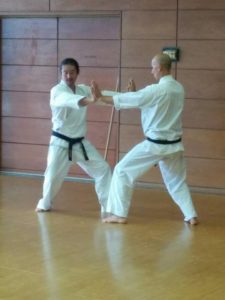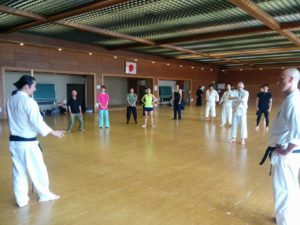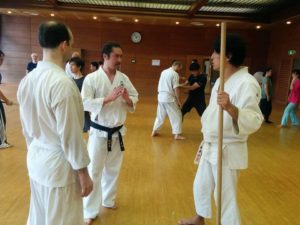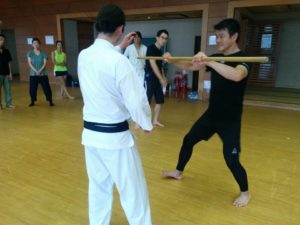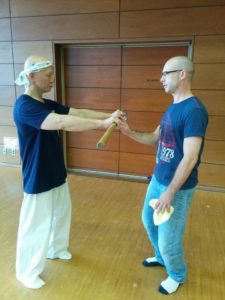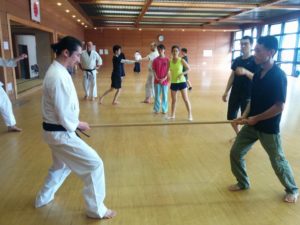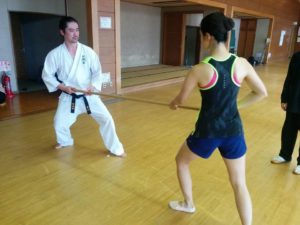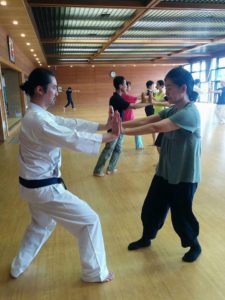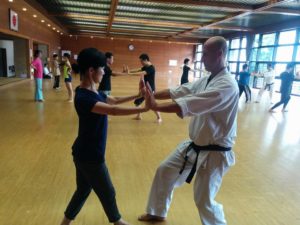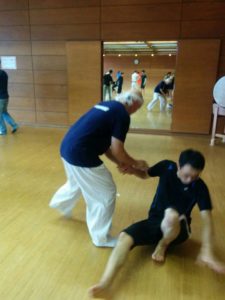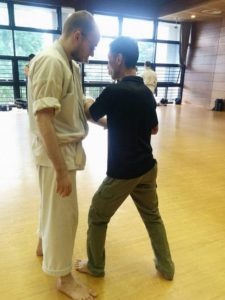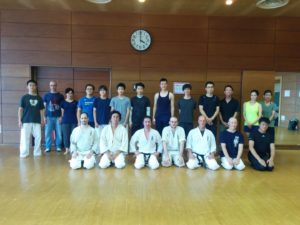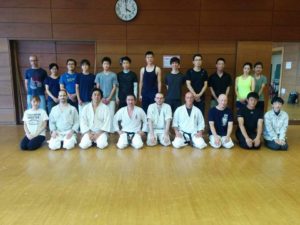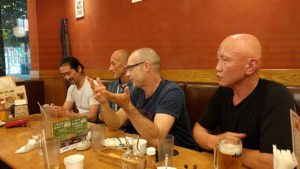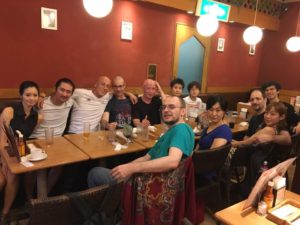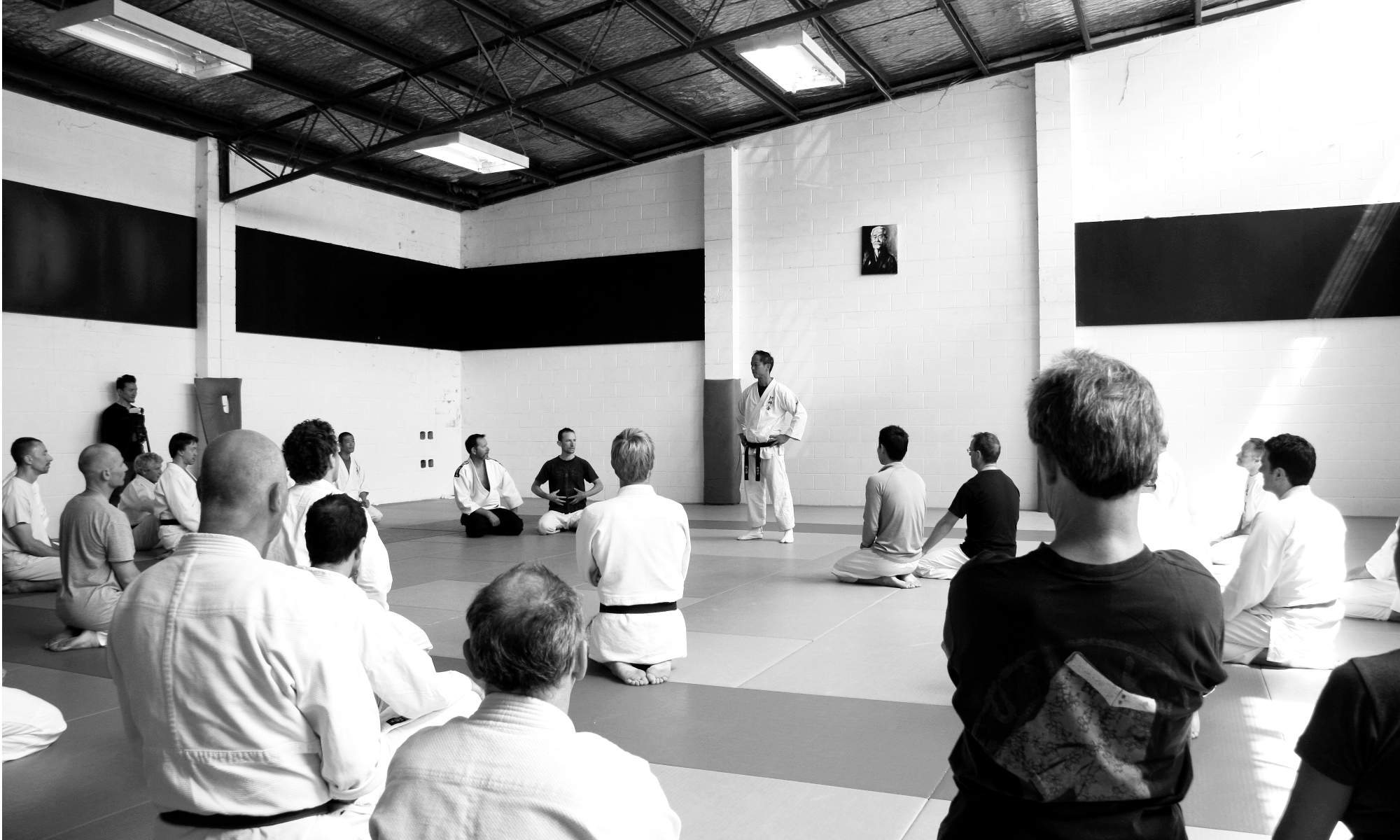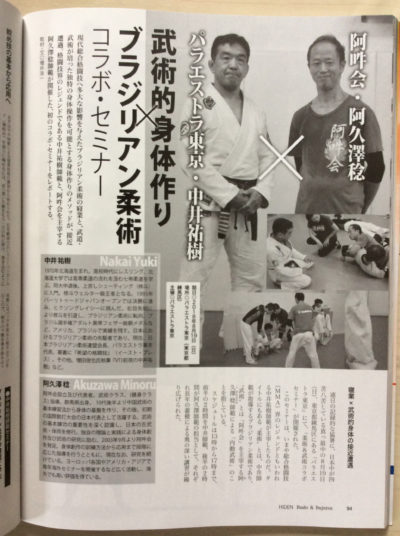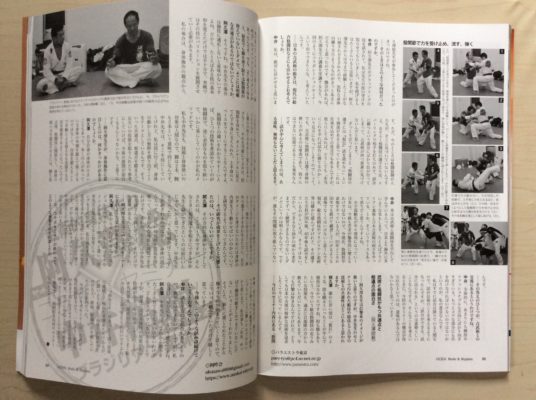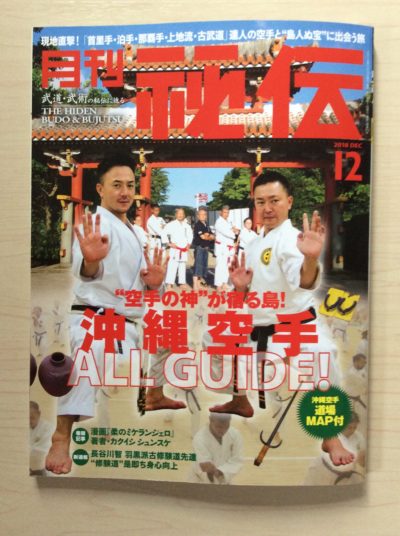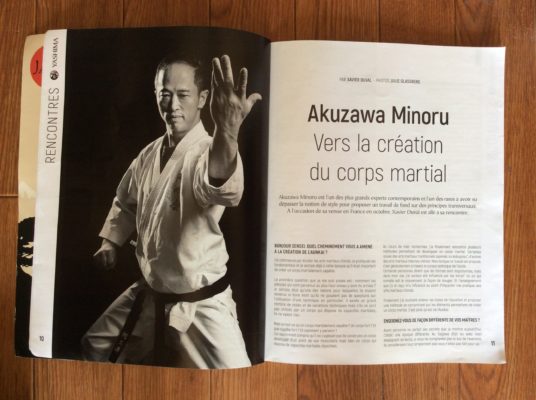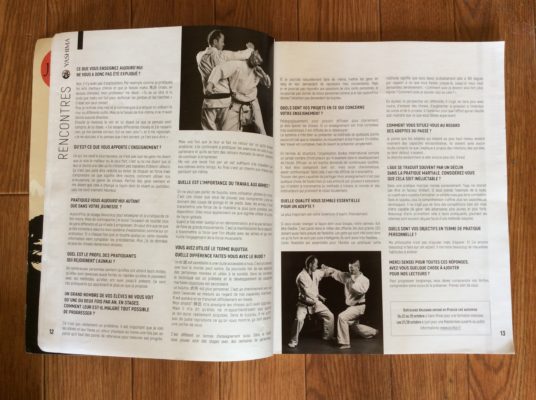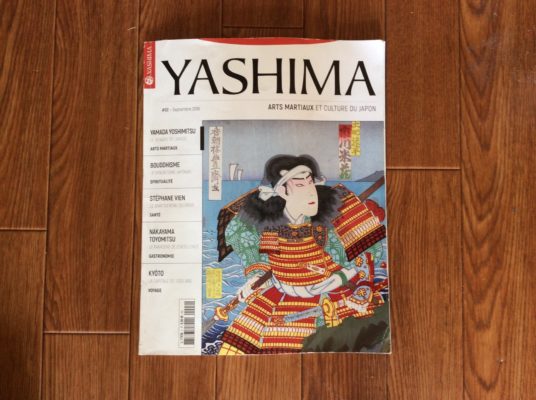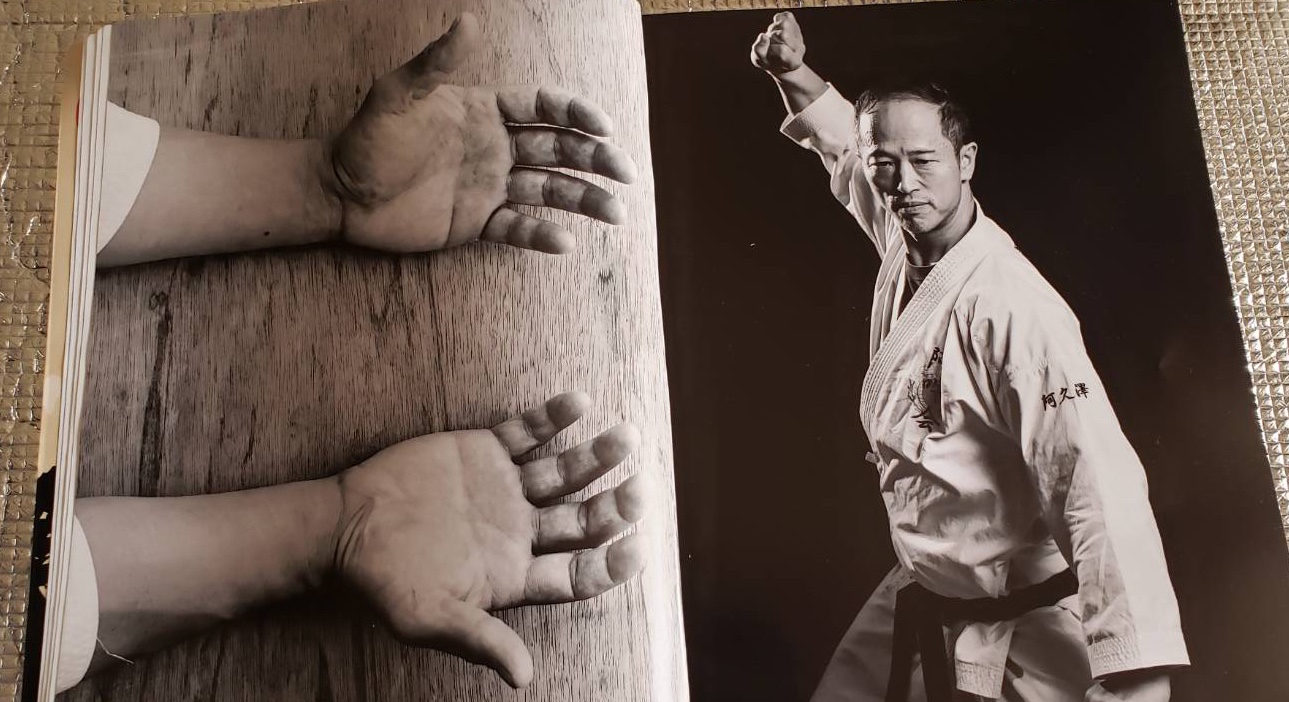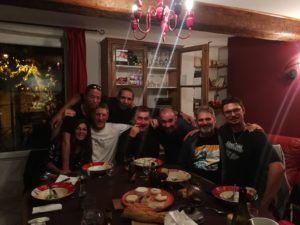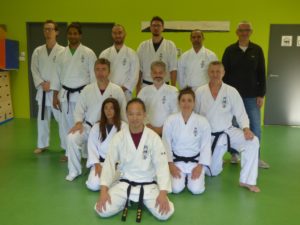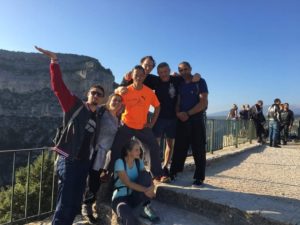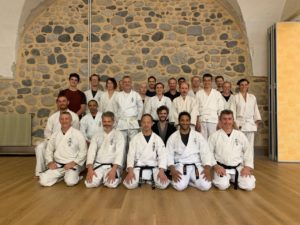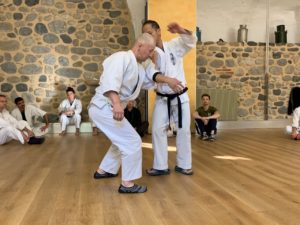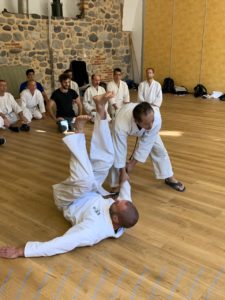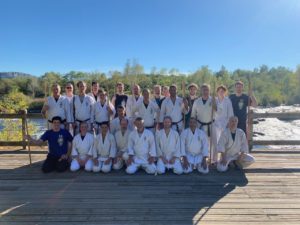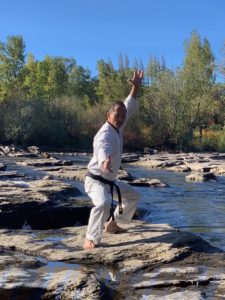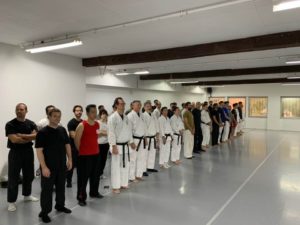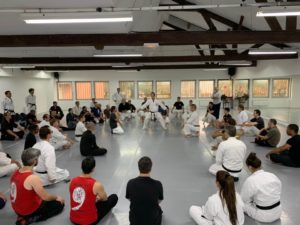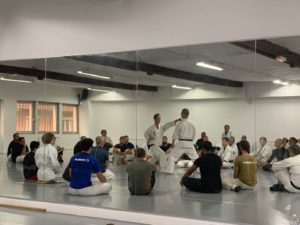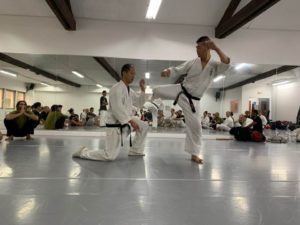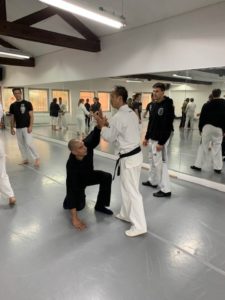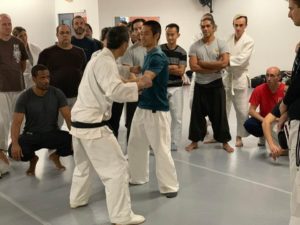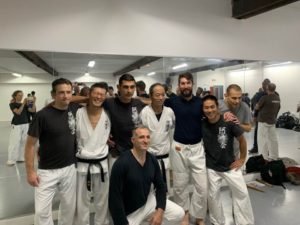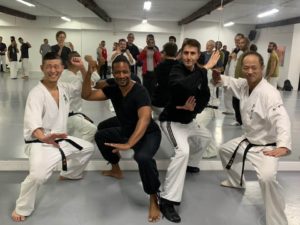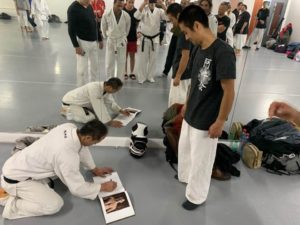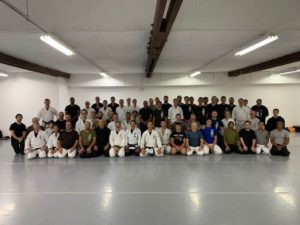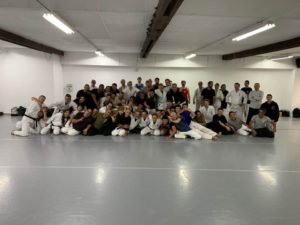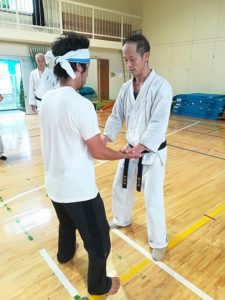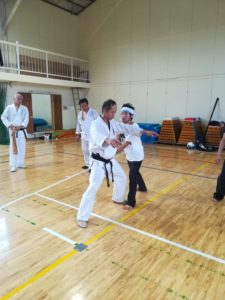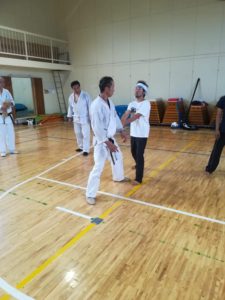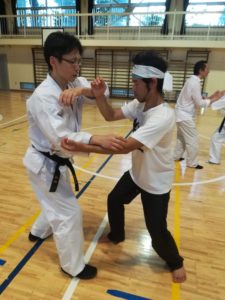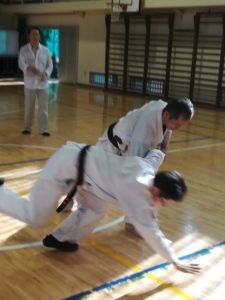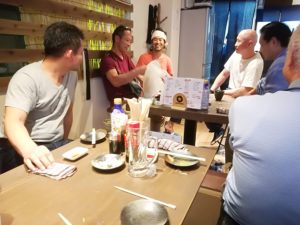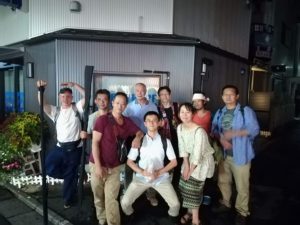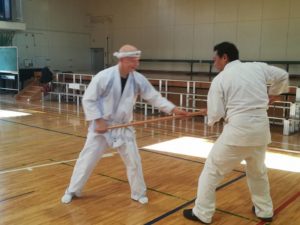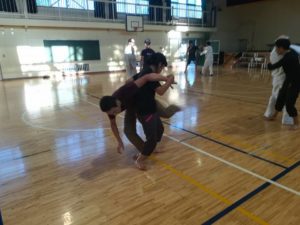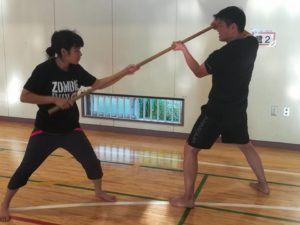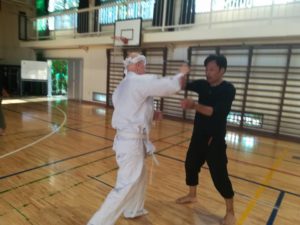2018-10 France Seminar
2018-09-17 Tokyo Open Seminar Report
Participants came from as far away as Nagano. And despite being autumn, the day was hot as summer, resulting in frequent water breaks.
Sensei concentrated on teaching the essentials of “relaxing” (in Japanese, “Chikara wo nuku”).
While some strength is needed, essentially, when changing posture and form, the parts used vary. As a teaching tool, one method of learning this with the elbow was introduced.
In this drill, the elbow is lifted while the partner is hanging vertically at the end of the wrist. The way of using the whole body from the feet and hips across the back and shoulders to lift the elbow is then the same as that use to strike with the fist, as sensei then demonstrated against pads—with the perceived weight the penetrative power of the strike a great surprise to the recipient!
One interpretation of “relaxing” in this particular case is to not use strength to interfere with the operation of the intended parts. However, just relaxing loosely is also useless; the correct posture to facilitate relaxation is necessary.
The next step was accepting and returning a pushing force against the hips from the front, and later from the side, but accepting and then returning to the original position by the release of the tension built up by accepting.
This was a great drill to learn the natural position, and accepting movement, required for the hips to work efficiently.
Building on the previous drills, sensei then had us go through a drill where the partner would push on the hands semi-freely, and the practitioner would try to accept and return the force without putting strength into the elbows.
The seminar provided a good change to touch people outside of the Aunkai training group.
Each partner’s individuality in performing drills was a chance to re-calibrate one’s own understanding of one’s body, and different errors came to light for correct.
It was brought home once more how despite the overt power evident in sensei’s movements, the core of the power comes from a detailed understanding and use of posture.
After the seminar a gathering for dinner was held close by, a happy conclusion to the hard work.
We are very grateful to all the participants, and to sensei for his valuable teaching.
2018-08-19 Traditional Martial Arts Collaborative Seminar: Yuki Nakai and Minoru Akuzawa
Teachers:
- Jujutsu master Yuki Nakai
- Aunkai founder Minoru Akuzawa
Format:
First half (2 hours): Nakai sensei
Second half (2 hours): Akuzawa sensei
The seminar is of a general nature, anyone interested is welcome to participate, experience not required.
Please apply using the email address listed below.
Details for “Traditional Martial Arts Collaborative Seminar: Yuki Nakai and Minoru Akuzawa”
Date: August 19th, 2018 (Sunday)
Time: 13:00-17:00
Participation fee: 5000 JPY (Paraestra members 3000 JPY)
Venue: Paraestra Tokyo
Address: Caesar Ekoda B1-101, 1-61-3 Toyotama-Kita, Nerima-ku, Tokyo
Closest Station:
(1) Subway Toei Ōedo Line Shin-Ekoda station, A2 exit(1 minute walk)
(2) Seibu Ikebukuro Line Ekoda stations, West exit (6 minute walk)
Applications:
- Email to: pare-tyo@pc4.so-net.ne.jp
Please write the following information in the email:- event name as above
- date as above
- full name
- Participation without prior arrangement is also welcome.
Notes:
Paraestra Home Page Announcement (In Japanese)
Paraestra Home Page (Japanese)
Paraesta Blog (English)
2006-09-18 Tokyo Sanda Seminar Report
Others here and elsewhere have written on the basic principles we use (body axes, centering, rooting, etc.) in much greater detail and in greater depth than I can, so I will leave the reader to explore them on their own. I will also assume the reader knows the rules of sanda and how a sanda match typically proceeds.

The sanda session we held here in Tokyo on September 18th, 2006, was to be my second attempt at applying those principles against a real live human opponent who would be trying to impose their own will upon me at the same time. My goals this time were the same as they were last time: remain calm, keep my structure intact, claim victory over my own fears and anxieties.
In the last session I accomplished some of those goals, and this time I was hoping to build on the experience and on my training in the interim. I am happy to say that I have made some progress, which I will report for you now.
My match was the first of the evening, and I was paired with a newcomer. A grappler, he is well built for the ground game. For stand-up, however, he seemed far too tense. In a way, this perhaps encouraged me to let go of my own tension, calm down, and deal with his attacks successfully. Of course, I took my own share of hits (including one that gave Mitsuhashi my back and very quickly ended the engagement), but for the most part I gave a good account of myself.
By the end of my match, I knew that I still had to work on pursuing my three goals, but I also knew that if I am able to do this much with little or no time dedicated to sparring practice, then the Aunkai way (Frame <> Principle <> Foundation) must be the real deal.
Watching the rest of the matches that day only reinforced my conclusions. In particular, the need to stay loose and fluid, the need to stay in gthe pocket?Ewith your assailant, and the ultimate futility of a purely technical approach were clear to me.
The next step for me is to constantly be training as though the next sanda session were tomorrow, since the pursuit and ultimately the accomplishment of my three goals can only lead me to one place: total control of the self, and therefore by extension control of my opponent to the point where the idea of gopposition?Eitself becomes unnecessary.
Long live the Aunkai!
(Adam Xavier/Aunkai bujutu class)


2018-09-17 Tokyo Open Seminar
One-day Aunkai Open Seminar in Tokyo given by Akuzawa sensei.
Theme: Unbalancing, and creation of a stable form
Aunkai has a strong focus on training in posture and use of center of gravity, to become stable in a manner transcending age.
What does it mean to talk about body usage that transcends age?
Why is it that this cannot be achieved without relaxation?
What is internal usage in comparison to external usage?
What kind of tanren is it that develops deep understanding of posture?
In this seminar, regardless of level, participants will experience the progression of training from contact, through unbalancing, to striking and free practice in a fun manner conducive to learning.
- Date: 17th September 2018 (Monday—public holiday)
- Venue: Musashinodai Primary School Gym Hall (Access information)
Address: 5-1-1 Kami-Saginomiya, Nakano-ku, Tokyo 165-0031 - Time: 13:00-17:00 (Meeting at 12:30 in front of Assembly Room)
- Fee: 6000 JPY (Aunkai members: 5000 JPY)
- Application: please use online application form.
Note: direct participation without prior application is not permitted.
Further Information
- Participation: 18 years or older and in good health. Experience not required. No other particular prerequisites.
- Clothing/footwear: clothing easy to move around in; indoor shoes (barefoot also OK).
- Other: please bring own water/drinks, towels.
- Dinner reservation: post-seminar dinner with sensei is planned (expected cost approximately 3000 JPY). A great time to ask questions, mix and mingle, and benefit from each other’s experiences.
Confirmations can be made in advance, with finalization during seminar break.
2018-02-12 Tokyo Open Seminar Report
The seminar at the Shinjuku Cosmic Sports Center (seminar details) passed all too quickly, with the participants, some from overseas, gathering a lot of information about posture and its applicability to transmitting the weight naturally, used in exercises for connecting with the partner, and making space inside the body for movement. Akuzawa Sensei’s topic for this seminar was how to train the body to overcome the limitations of age.
The initial part of the seminar involved stretching, especially the inner hip joint, inwards and outwards, on the ground, and then using the spine and hips to crawl forwards on the belly, followed by similarly on one’s back. This type of movement training is intended to help form a connected relaxed body without relaying on the upper body and shoulders to initiate movement.
Thereafter, a very difficult and important partner exercise commenced, where one person stood heels and back flat against the wall, and the partner pushed in turn against the upper chest, middle chest, or abdomen with one hand. The objective was to stand straight against the wall, and practice using the slight tilting and straightening of the back and corresponding sinking of the body in the inner hip joint to absorb and return the push and thereby initiate forward movement. The creation of “space” between joints allows the internal realignment and dispersion of external force, and requires relaxation and self-awareness of one’s body structure and the ability to manipulate it sensitively.
Next, the same type of connection was practiced without a wall as support. The person being pushed would absorb the push through the aforementioned straightening and sinking relaignment, and then let the hips glide forwards to one side of the pushing partner, legs following appropriately, sinking towards the ground, taking the partner with them if done smoothly. This “catching” of the push and subsequent ease of movement together with the connected partner, forms an important cornerstone of skill in unbalancing.
Having an entire seminar available to concentrate on a few critical aspects of training was a valuable experience for newcomers and regular members alike, and everyone felt grateful for the opportunity to learn from sensei and to explore this body movement with partners and integrate it further into their own practice.
Many thanks to all who attended.
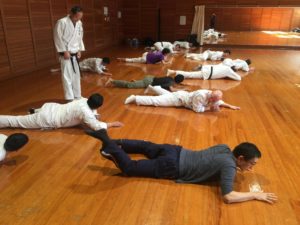
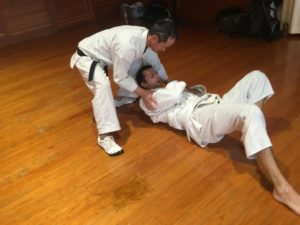
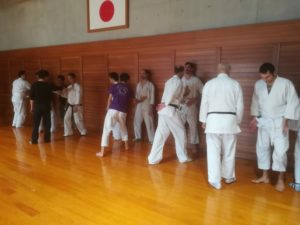
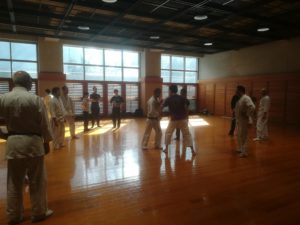
2018-02-12 Tokyo Open Seminar
One-day Aunkai Open Seminar in Tokyo given by Akuzawa sensei.
Venue is the Cosmic Sports Center in Shinjuku.
Theme: Deepening the study of body transformation.
- Date: 12th February 2018 (Monday—public holiday)
- Venue: Cosmic Sports Center, Shinjuku, Tokyo. First floor No. 2 Budo dojo (Access information)
- Time: 12:10-15:10
- Fee: 6000 JPY (Aunkai members: 5000 JPY)
- Application: please use online application form.
- Related: announcement in online version of the Hiden Journal
Seminar Contents
The theme of the seminar revolves around how to break out of the standard model of body usage, transform it and thus become free from the limitations imposed by age.
The way to achieve this in Aunkai is to diligently train in specific methods based on body principles and thereby to foster a new realization and mentality. This seminar will teach the practice of these specific methods.
Sports martial artists looking for ways to improve their skills, martial arts enthusiasts interested in deepening their knowledge of the body, and anyone interested in Bujutsu from beginner level is welcome, and should equally find the content of value and interest.
Application should be made via the online form above.
Further Information
- Participation: aimed at experienced martial arts, beginners very welcome as always.
- Clothing/footwear: clothing easy to move around in; indoor shoes (barefoot also OK).
- Other: please bring own water/drinks, towels.
- Dinner reservation: post-seminar dinner with sensei is planned (expected cost approximately 3000 JPY). A great time to ask questions, mix and mingle, and benefit from each other’s experiences.
Confirmations can be made in advance, with finalization during seminar break.
2017-09-18 Tokyo Open Seminar Report
Impression and Report
Despite the location being on the outskirts of Tokyo, it turned out to be very successful and a pleasurable experience for all participants, who enjoyed the intensive time spent on partner exercises designed to give feedback for one’s own training.
Attendees numbered 14, with about half being members from the Aunkai organization, as well as a few repeat attendees who had experienced Akuzawa sensei’s seminars before. Among the new attendees was a gentleman from Kyushu, and one who had seen sensei’s interview on Youtube, as well as a lady boxing practitioner.
Sensei began the seminar with detailed versions of walking exercises, where one partner pushed on the other’s chest and the pushed person walked backwards without bracing, endeavouring to drop the push down the chest into the kua.
From that exercise, we moved on to walking with both arms extended, elbows straight, hands touching, and attempting to walk without leaning or bracing, using the drop of the chest and the turn of the kua in cooperation.
Since the seminar was 4 hours long, and the day extremely hot after a typhoon the previous day, there were offcial water breaks every hour, and informal ones as the need arose.
The next type of exercise involved one partner standing in wide stance with kua bent, with the other person pushing against the belly in a committed manner, just enough to put the pushed person at the limit of what they could absorb.
The objective from here was to rely on the platform created by kua rotation and chest drop, and use the legs to step and then simply drop, leaving the partner to feel glued or stuck to the belly.
After training pushing against the belly, the push position was changed to the middle of the torso, and then the chest. Feeling oneself on a platform without leaning, having free use of the legs without bracing, and sensing oneself as a unit with the partner attached, was a good introduction to how to deal with an incoming force such as a punch, as sensei demonstrated, handling it at the moment of contact in exactly the same way.
Sensei had participants train two to a staff for a while, to experience moving freely with a solid contact between the two partners. Owing to the heat, this training was done quite lightly, as people concentrated on getting their body to hold the lessons from the previous exercises.
Finally we practiced movement and application against a simple straight punch from the partner, with sensei giving instruction to individuals on how best to adjust their body usage to keep a unit-like sense and avoid using normal strength. This was both relaxing and freeing, a great balance to the constrained exercises.
After the seminar a number of participants joined in for a reserved dinner and chat until late in the evening, gaining even more open discussion with sensei.
Photos
2017-08-13 Tokyo Free Open Seminar Report
Message from Miyakawa hanshi:
Thank you very much for attending the Aunkai trial seminar on August 13th.
I hope you enjoyed and understood Aunkai method.
I would really like to see you soon again.
Impression and Report
The seminar garnered attention for being free, and is a milestone for the Aunkai organization in being the first seminar in Japan given by Miyakawa hanshi. It turned out to be very successful and a pleasurable experience for all participants, making full use of Miyakawa hanshi’s extensive experience teaching overseas in Europe over the last few years.
Attendees numbered 23, with about 10 members from the Aunkai organization among them, as well as a few repeat attendees who had experienced Akuzawa sensei’s seminars before.
Miyakawa hanshi began with a brief overview of the Aunkai method, demonstrating with French instructor Richard Segissement (kyoshi) as his partner. The main point conveyed were the use of a connected body to transmit center of mass without pushing off the ground, punctuated by demonstrations with the rokushakubo and with empty hands to move the partner seemingly effortlessly, when compared to trying to do the same thing with so-called ordinary strength.
Since the seminar was 3.5 hours long, and the day humid and hot, there were water breaks every 30 minutes or so, giving people time to regain their energy.
The exercises Miyakawa hanshi had participants do are all standard Aunkai partner warm-up exercises, and the focus was purely on feeling a connected body, and obtaining a sensation of affecting the partner through transmission of center of mass with relaxed hips and without any use of the knees or upper body tilting.
Pushout proved to be a popular exercise, as it has been found throughout the world where Aunkai is spread! Finally, some breaking balance exercises were done for the last 20 minutes or so, giving participants a feel for how relatively easily a partner can be affected.
One tanren exercise was shown and practiced together near the end of the seminar: Ten-chi-jin. After working on a connected body and affecting as well as being affected by
the partner, the idea is that it would be easier to grasp the essential elements of the tanren.
After the seminar a number of participants joined in an impromptu dinner and chat until evening, bringing to an end a very enjoyable day of mutual training and learning.
Media and Photos
Miyakawa Kazuhisa hanshi with Richard Segissement kyoshi demonstrating transmission of center of mass.
Miyakawa Kazuhisa hanshi with Richard Segissement kyoshi demonstrating transmission of center of mass.
Miyakawa Kazuhisa hanshi with Richard Segissement kyoshi demonstrating transmission of center of mass.
